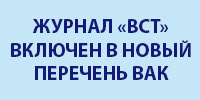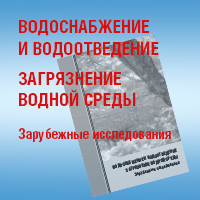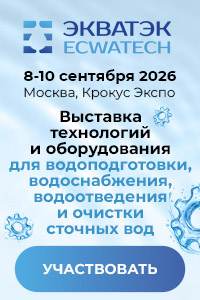№6|2025
WATER TREATMENT
UDC 628.16:574.58
DOI 10.35776/VST.2025.06.01
Natural water purification using Chlorella microalgae
Summary
The results of studying the process of bioremediation of natural water using Chlorella microalgae, including mechanisms of pollution absorption, optimal conditions for microalgae culturing, and an estimation of the impact of purified water on the environment are presented. The purpose of this study is investigating the effect of different doses of Chlorella suspension on the removal of nitrogen, ammonia, and turbidity reduction in natural water. The experiment was carried out using Chlorella vulgaris microalgae culture with a concentration of 1.5 g/l. Natural water taken from the Iauza River was used as the test sample. During the 21-day experiment, a constant temperature of 25 °C and continuous illumination of 5000 lux were maintained. A turbidity meter HACH 2100N was used to determine the water turbidity. Concentrations of nutrients were determined using NKV-1 field laboratory for water analysis. The experimental study showed that the sample with 0.3 g/l Chlorella dose provided for the best results in terms of water quality: the nitrite concentration decreased to a minimum value of 0.01 mg/l, the nitrate concentration reached a minimum value of 0.001 mg/l (corresponding to the lower limit of sensitivity of the test method), the turbidity decreased from 2.61 to 0.58 mg/l.
Key words
turbidity , natural water , nutrients removal , Chlorella microalgae
For citation: Ksenofontov B. S., Tiumentseva M. V., Serov S. A. Natural water purification using Chlorella microalgae. Vodosnabzhenie i Sanitarnaia Tekhnika, 2025, no. 6, pp. 4–9. DOI: 10.35776/VST.2025.06.01. (In Russian).
The further text is accessible on a paid subscription.
For authorisation enter the login/password.
Or subscribe
REFERENCES
- Ксенофонтов Б. С. Парниковые газы: утилизация с использованием биотехнологических установок. – М.: НИЦ ИНФРА-М, 2023. 225 с.
Ksenofontov B. S. Parnikovye gazy: utilizatsiia s ispol’zovaniem biotekhnologicheskikh ustanovok [Greenhouse gases: utilization with the use of biotechnological units. Moscow, NITS INFRA-M Publ., 2023, 225 p.]. - An J. Y., Sim S. J., Lee J. S. et al. Hydrocarbon production from secondarily treated piggery wastewater by the green alga Botryococcus braunii. Journal of Applied Phycology, 2003, v. 15, pp. 185–191. DOI 10.1023/A:1023855710410.
- Kim J. et al. Removal of ammonia from wastewater effluent by Chlorella vulgaris. Tsinghua Science and Technology, 2010, v. 15, no. 4, pp. 391–396.
- Kong Q. et al. Culture of microalgae Chlamydomonas reinhardtii in wastewater for biomass feedstock production. Applied biochemistry and Biotechnology, 2010, v. 160, pp. 9–18.
- Aslan S., Kapdan I. K. Batch kinetics of nitrogen and phosphorus removal from synthetic wastewater by algae. Ecological Engineering, 2006, v. 28, no. 1, pp. 64–70.
- Tarlan E., Dilek F. B., Yetis U. Effectiveness of algae in the treatment of a wood-based pulp and paper industry wastewater. Bioresource Technology, 2002, v. 84, no. 1, pp. 1–5.
- Alazaiza M. Y. D. et al. Sewage water treatment using Chlorella vulgaris microalgae for simultaneous nutrient separation and biomass production. Separations, 2023, v. 10, no. 4, p. 229.






